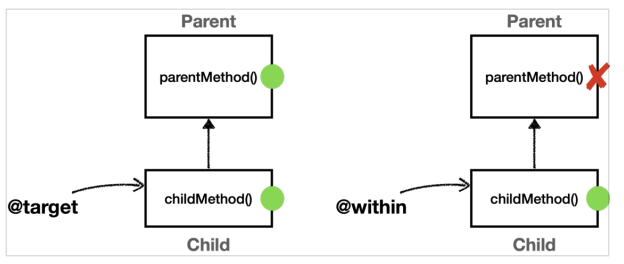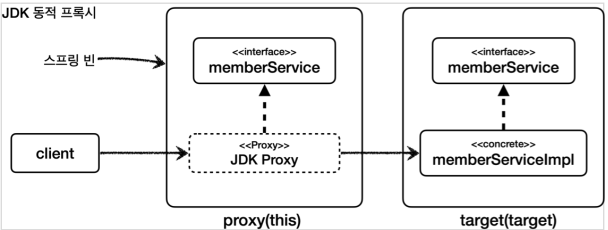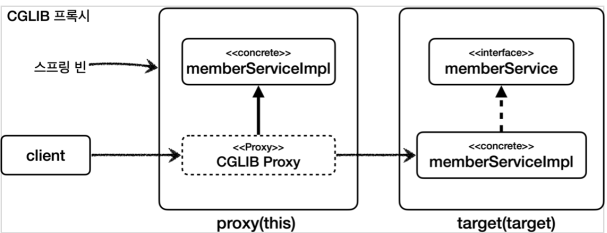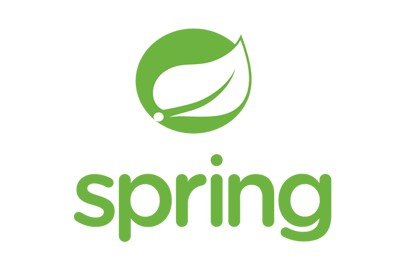- 스프링 핵심원리 고급편 예제만들기
- 스프링 핵심원리 고급편(2) 쓰레드 로컬(threadlocal)
- 스프링 핵심원리 고급편(3) 템플릿 메서드 패턴과 콜백 패턴
- 스프링 핵심원리 고급편 프록시 패턴과 데코레이터 패턴
- 스프링 핵심원리 고급편(2) 동적 프록시 기술
- 스프링 핵심원리 고급편 스프링이 지원하는 프록시
- 스프링 핵심원리 고급편(2) 빈 후처리기
- 스프링 핵심원리 고급편(3) @aspect aop
- 스프링 핵심원리 고급편(3) 스프링 aop 구현
- 스프링 핵심원리 고급편 스프링 aop 포인트컷
- 스프링 핵심원리 고급편 스프링 aop 실전 예제
- 스프링 핵심원리 고급편(2) 스프링 aop 실무 주의사항
스프링 핵심원리 고급편 스프링 aop 포인트컷
0. 포인트컷 지시자
AspectJ 는 포인트컷을 편리하게 표현하기 위한 특별한 표현식을 제공한다.
ex) @Pointcut("execution(* hello.aop.order..*(..))")
포인트컷 지시자
포인트컷 표현식은 execution 같은 포인트컷 지시자(Pointcut Designator)로 시작한다. 줄여서 PCD라 한다.
포인트컷 지시자의 종류
- execution : 메소드 실행 조인 포인트를 매칭한다. 스프링 AOP에서 가장 많이 사용하고, 기능도 복잡하다.
- within : 특정 타입 내의 조인 포인트를 매칭한다.
- args : 인자가 주어진 타입의 인스턴스인 조인 포인트
- this : 스프링 빈 객체(스프링 AOP 프록시)를 대상으로 하는 조인 포인트
- target : Target 객체(스프링 AOP 프록시가 가르키는 실제 대상)를 대상으로 하는 조인 포인트
- @target : 실행 객체의 클래스에 주어진 타입의 애노테이션이 있는 조인 포인트
- @within : 주어진 애노테이션이 있는 타입 내 조인 포인트
- @annotation : 메서드가 주어진 애노테이션을 가지고 있는 조인 포인트를 매칭
- @args : 전달된 실제 인수의 런타임 타입이 주어진 타입의 애노테이션을 갖는 조인 포인트
- bean : 스프링 전용 포인트컷 지시자, 빈의 이름으로 포인트컷을 지정한다
1. 예제 만들기
포인트 컷 표현식을 이해하기 위한 예제
ClassAop
package hello.aop.order.aop.member.annotation;
import java.lang.annotation.ElementType;
import java.lang.annotation.Retention;
import java.lang.annotation.RetentionPolicy;
import java.lang.annotation.Target;
@Target(ElementType.TYPE)
@Retention(RetentionPolicy.RUNTIME)
public @interface ClassAop {
}
MethodAop
package hello.aop.order.aop.member.annotation;
import java.lang.annotation.ElementType;
import java.lang.annotation.Retention;
import java.lang.annotation.RetentionPolicy;
import java.lang.annotation.Target;
@Target(ElementType.METHOD)
@Retention(RetentionPolicy.RUNTIME)
public @interface MethodAop {
String value();
}
MemberService
package hello.aop.order.aop.member;
public interface MemberService {
String hello(String param);
}
MemberServiceImpl
package hello.aop.order.aop.member;
import hello.aop.order.aop.member.annotation.ClassAop;
import hello.aop.order.aop.member.annotation.MethodAop;
import org.springframework.stereotype.Component;
@ClassAop
@Component
public class MemberServiceImpl implements MemberService {
@Override
@MethodAop("test value")
public String hello(String param) {
return "ok";
}
public String internal(String param){
return "ok";
}
}
Test
ExecutionTest
package hello.aop.pointcut;
import hello.aop.order.aop.member.MemberServiceImpl;
import lombok.extern.slf4j.Slf4j;
import org.junit.jupiter.api.BeforeEach;
import org.junit.jupiter.api.Test;
import org.springframework.aop.aspectj.AspectJExpressionPointcut;
import java.lang.reflect.Method;
@Slf4j
public class ExecutionTest {
AspectJExpressionPointcut pointcut = new AspectJExpressionPointcut();
Method helloMethod;
@BeforeEach
public void init() throws NoSuchMethodException {
helloMethod = MemberServiceImpl.class.getMethod("hello", String.class);
}
@Test
void printMethod(){
//public java.lang.String hello.aop.order.aop.member.MemberServiceImpl.hello(java.lang.String)
log.info("helloMethod = {}", helloMethod);
}
}
- AspectJExpressionPointcut 이 바로 포인트컷 표현식을 처리해주는 클래스다. AspectJExpressionPointcut 는 상위에 Pointcut 인터페이스를 가진다.
2. execution 사용 (test)
execution 문법
execution(modifiers-pattern? ret-type-pattern declaring-type-pattern?namepattern(param-pattern)
throws-pattern?)
--> execution(접근제어자? 반환타입 선언타입?메서드이름(파라미터) 예외?
?가 붙으면 생략가능하다.
ExecutionTest
"execution(* 패키지..*(..))" 로 패키지 하위의 모든 패키지의 메서드에 대해 포인트 컷을 지정할 수 있다.
package hello.aop.pointcut;
import hello.aop.member.MemberServiceImpl;
import lombok.extern.slf4j.Slf4j;
import org.junit.jupiter.api.BeforeEach;
import org.junit.jupiter.api.Test;
import org.springframework.aop.aspectj.AspectJExpressionPointcut;
import java.lang.reflect.Method;
import static org.assertj.core.api.Assertions.*;
@Slf4j
public class ExecutionTest {
AspectJExpressionPointcut pointcut = new AspectJExpressionPointcut();
Method helloMethod;
@BeforeEach
public void init() throws NoSuchMethodException {
helloMethod = MemberServiceImpl.class.getMethod("hello", String.class);
}
@Test
void printMethod(){
//public java.lang.String hello.aop.member.MemberServiceImpl.hello(java.lang.String)
log.info("helloMethod = {}", helloMethod);
}
@Test
void exactMatch(){
//정확하게 매칭
//public java.lang.String hello.aop.member.MemberServiceImpl.hello(java.lang.String)
pointcut.setExpression("execution(public java.lang.String hello.aop.member.MemberServiceImpl.hello(java.lang.String))");
assertThat(pointcut.matches(helloMethod, MemberServiceImpl.class)).isTrue();
}
@Test
void allMatch(){
//가장 많이 생략한 포인트 컷
pointcut.setExpression("execution(* *(...))");
assertThat(pointcut.matches(helloMethod, MemberServiceImpl.class)).isTrue();
}
@Test
void nameMatch() {
//메서드 이름이 hello 인 모든 메서드
pointcut.setExpression("execution(* hello(..))");
assertThat(pointcut.matches(helloMethod, MemberServiceImpl.class)).isTrue();
}
@Test
void nameMatchStar1() {
//메서드 이름이 hel 로 시작하는 모든 메서드
pointcut.setExpression("execution(* hel*(..))");
assertThat(pointcut.matches(helloMethod, MemberServiceImpl.class)).isTrue();
}
@Test
void nameMatchStar2(){
//메서드 이름에 ll 을 포함하는 모든 메서드
pointcut.setExpression("execution(* *ll*(..))");
assertThat(pointcut.matches(helloMethod, MemberServiceImpl.class)).isTrue();
}
@Test
void nameMatchFalse(){
//메서드 이름을 no 로 하여 매칭되는 메서드가 없게 함
pointcut.setExpression("execution(* no(..))");
assertThat(pointcut.matches(helloMethod, MemberServiceImpl.class)).isFalse();
}
@Test
void PackageExactMatch1() {
//hello.aop.member.MemberServiceImpl 하위의 hello 메서드
pointcut.setExpression("execution(* hello.aop.member.MemberServiceImpl.hello(..))");
assertThat(pointcut.matches(helloMethod, MemberServiceImpl.class)).isTrue();
}
@Test
void PackageExactMatch2() {
//hello.aop.member 패키지의 모든 클래스에 대한 hello 메서드
pointcut.setExpression("execution(* hello.aop.member.*.*(..))");
assertThat(pointcut.matches(helloMethod, MemberServiceImpl.class)).isTrue();
}
@Test
void PackageExactFalse() {
//hello.aop 패키지의 모든 클래스에 대한 hello 메서드
//aop 하위의 클래스에 hello 메서드가 없으므로 오류
pointcut.setExpression("execution(* hello.aop.*.*(..))");
assertThat(pointcut.matches(helloMethod, MemberServiceImpl.class)).isFalse();
}
@Test
void PackageMatchSubPackage1() {
//member 패키지와 그 하위 패키지에 있는 모든 클래스의 모든 메서드
pointcut.setExpression("execution(* hello.aop.member..*.*(..))");
assertThat(pointcut.matches(helloMethod, MemberServiceImpl.class)).isTrue();
}
@Test
void PackageMatchSubPackage2() {
//aop 패키지와 그 하위 패키지에 있는 모든 클래스의 모든 메서드
pointcut.setExpression("execution(* hello.aop..*.*(..))");
assertThat(pointcut.matches(helloMethod, MemberServiceImpl.class)).isTrue();
}
}
hello.aop.member.*(1).*(2): (1) 타입 (2) 메서드 이름
3. execution 사용 2 (test)
@Test
void typeExactMatch() {
//타입에 정확히 매칭
pointcut.setExpression("execution(* hello.aop.member.MemberServiceImpl.*(..))");
assertThat(pointcut.matches(helloMethod, MemberServiceImpl.class)).isTrue();
}
@Test
void typeMatchSuperType() {
//부모타입에 매칭해도 자식 타입도 포함 (MemberService)
pointcut.setExpression("execution(* hello.aop.member.MemberService.*(..))");
assertThat(pointcut.matches(helloMethod, MemberServiceImpl.class)).isTrue();
}
@Test
void typeMatchInternal() throws NoSuchMethodException {
//MemberServiceImpl 의 내부 메서드도 포함
pointcut.setExpression("execution(* hello.aop.member.MemberServiceImpl.*(..))");
Method internalMethod = MemberServiceImpl.class.getMethod("internal", String.class);
assertThat(pointcut.matches(internalMethod, MemberServiceImpl.class)).isTrue();
}
@Test
void typeMatchNoSuperTypeMethodFalse() throws NoSuchMethodException {
//부모타입(MemberService) 에서 선언하지 않은 자식타입(MemberServiceImpl) 의 메서드는 포함되지 않음
pointcut.setExpression("execution(* hello.aop.member.MemberService.*(..))");
Method internalMethod = MemberServiceImpl.class.getMethod("internal", String.class);
assertThat(pointcut.matches(internalMethod, MemberServiceImpl.class)).isFalse();
}
@Test
void argsMatch(){
//String 타입인 파라미터 허용
pointcut.setExpression("execution(* *(String))");
assertThat(pointcut.matches(helloMethod, MemberServiceImpl.class)).isTrue();
}
@Test
void argsMatchNoArgs(){
//파라미터가 없어야 함
pointcut.setExpression("execution(* *())");
assertThat(pointcut.matches(helloMethod, MemberServiceImpl.class)).isFalse();
}
@Test
void argsMatchStar(){
//정확히 하나의 파라미터 허용, 모든 타입 허용
pointcut.setExpression("execution(* *(*))");
assertThat(pointcut.matches(helloMethod, MemberServiceImpl.class)).isTrue();
}
@Test
void argsMatchAll(){
//(), (xxx), (xxx, xxx) 모두 허용
//숫자와 무관하게 모든 파라미터, 모든 타입 허용
pointcut.setExpression("execution(* *(..))");
assertThat(pointcut.matches(helloMethod, MemberServiceImpl.class)).isFalse();
}
@Test
void argsMatchComplex(){
//(String), (String, xxx), (String, xxx, xxx) 모두 허용
//String 타입으로 시작, 숫자와 무관하게 모든 파라미터, 모든 타입 허용
pointcut.setExpression("execution(* *(String, ..))");
assertThat(pointcut.matches(helloMethod, MemberServiceImpl.class)).isTrue();
}
@Test
void argsMatchComplex2(){
//(String, xxx) 허용, 파라미터 개수는 2개
//String 타입으로 시작, 숫자와 무관하게 모든 파라미터, 모든 타입 허용
pointcut.setExpression("execution(* *(String, *))");
assertThat(pointcut.matches(helloMethod, MemberServiceImpl.class)).isFalse();
}
execution 파라미터 매칭 규칙
- (String) : 정확하게 String 타입 파라미터
- () : 파라미터가 없어야 한다.
- (*) : 정확히 하나의 파라미터, 단 모든 타입을 허용한다.
- (*, *) : 정확히 두 개의 파라미터, 단 모든 타입을 허용한다.
- (..) : 숫자와 무관하게 모든 파라미터, 모든 타입을 허용한다. 참고로 파라미터가 없어도 된다. 0..* 로 이해하면 된다.
- (String, ..) : String 타입으로 시작해야 한다. 숫자와 무관하게 모든 파라미터, 모든 타입을 허용한다.
- 예) (String) , (String, Xxx) , (String, Xxx, Xxx) 허용
- (String, *) : String 타입으로 시작해야 하며 두 개의 파라미터만 허용한다.
4. Within 문법
within 지시자는 특정 타입 내의 조인 포인트들로 매칭을 제한한다. 쉽게 이야기해서 해당 타입이 매칭되면 그 안의 메서드(조인 포인트)들이 자동으로 매칭된다. 문법은 단순한데 execution 에서 타입 부분만 사용한다고 보면 된다.
package hello.aop.pointcut;
import hello.aop.member.MemberServiceImpl;
import lombok.experimental.StandardException;
import org.assertj.core.api.Assertions;
import org.junit.jupiter.api.BeforeEach;
import org.junit.jupiter.api.Test;
import org.springframework.aop.aspectj.AspectJExpressionPointcut;
import java.lang.reflect.Method;
import static org.assertj.core.api.Assertions.*;
public class WithinTest {
AspectJExpressionPointcut pointcut = new AspectJExpressionPointcut();
Method helloMethod;
@BeforeEach
public void init() throws NoSuchMethodException {
helloMethod = MemberServiceImpl.class.getMethod("hello", String.class);
}
@Test
void withinExact() {
//hello.aop.member.MemberServiceImpl 클래스 내에 있는 모든 메서드
pointcut.setExpression("within(hello.aop.member.MemberServiceImpl)");
assertThat(pointcut.matches(helloMethod, MemberServiceImpl.class)).isTrue();
}
@Test
void withinStar(){
pointcut.setExpression("within(hello.aop.member.*Service*)");
assertThat(pointcut.matches(helloMethod, MemberServiceImpl.class)).isTrue();
}
@Test
void withinSubPackage() {
//hello.aop 패키지와 그 하위 패키지에 있는 모든 클래스의 모든 메서드
pointcut.setExpression("within(hello.aop..*)");
assertThat(pointcut.matches(helloMethod, MemberServiceImpl.class)).isTrue();
}
@Test
void withinSuperTypeFalse() {
//타겟의 타입에만 직접 적용되며 인터페이스를 선정하면 안됨
pointcut.setExpression("within(hello.aop.member.MemberService)");
assertThat(pointcut.matches(helloMethod, MemberServiceImpl.class)).isFalse();
}
@Test
void executionSuperTypeTrue() {
//위와 달리 execution 은 타입 기반으로, 인터페이스 선정이 가능
pointcut.setExpression("execution(* hello.aop.member.MemberService.*(..))");
assertThat(pointcut.matches(helloMethod, MemberServiceImpl.class)).isTrue();
}
}
5. args 문법
메서드의 args 로 판단하는 문법이다. 많이 쓰이지 않는다. 사용법은 아래와 같다.
package hello.aop.pointcut;
import hello.aop.member.MemberServiceImpl;
import org.junit.jupiter.api.BeforeEach;
import org.junit.jupiter.api.Test;
import org.springframework.aop.aspectj.AspectJExpressionPointcut;
import java.lang.reflect.Method;
import static org.assertj.core.api.Assertions.assertThat;
public class ArgsTest {
Method helloMethod;
@BeforeEach
public void init() throws NoSuchMethodException {
helloMethod = MemberServiceImpl.class.getMethod("hello", String.class);
}
private AspectJExpressionPointcut pointcut(String expression) {
AspectJExpressionPointcut pointcut = new AspectJExpressionPointcut();
pointcut.setExpression(expression);
return pointcut;
}
@Test
void args() {
//hello(String)과 매칭
assertThat(pointcut("args(String)")
.matches(helloMethod, MemberServiceImpl.class)).isTrue();
//String 타입은 Object 의 자식타입이므로 허용됨
assertThat(pointcut("args(Object)")
.matches(helloMethod, MemberServiceImpl.class)).isTrue();
//기본적인 내용은 exucution 의 파라미터와 같다
assertThat(pointcut("args()")
.matches(helloMethod, MemberServiceImpl.class)).isFalse();
assertThat(pointcut("args(..)")
.matches(helloMethod, MemberServiceImpl.class)).isTrue();
assertThat(pointcut("args(*)")
.matches(helloMethod, MemberServiceImpl.class)).isTrue();
assertThat(pointcut("args(String,..)")
.matches(helloMethod, MemberServiceImpl.class)).isTrue();
}
/**
* execution(* *(java.io.Serializable)): 메서드의 시그니처로 판단 (정적)
* args(java.io.Serializable): 런타임에 전달된 인수로 판단 (동적)
*/
@Test
void argsVsExecution() {
//Args
assertThat(pointcut("args(String)")
.matches(helloMethod, MemberServiceImpl.class)).isTrue();
//String 의 부모타입은 Serializable 로도 정상 실행됨
assertThat(pointcut("args(java.io.Serializable)")
.matches(helloMethod, MemberServiceImpl.class)).isTrue();
assertThat(pointcut("args(Object)")
.matches(helloMethod, MemberServiceImpl.class)).isTrue();
//Execution
assertThat(pointcut("execution(* *(String))")
.matches(helloMethod, MemberServiceImpl.class)).isTrue();
assertThat(pointcut("execution(* *(java.io.Serializable))") //매칭 실패
.matches(helloMethod, MemberServiceImpl.class)).isFalse();
assertThat(pointcut("execution(* *(Object))") //매칭 실패
.matches(helloMethod, MemberServiceImpl.class)).isFalse();
}
}
6. @target, @within
주어진 타입의 어노테이션이 있는지 확인하여 pointcut 을 적용합니다.
@target vs @within
- @target 은 인스턴스의 모든 메서드를 조인 포인트로 적용한다.
- @within 은 해당 타입 내에 있는 메서드만 조인 포인트로 적용한다.
쉽게 이야기해서 @target 은 부모 클래스의 메서드까지 어드바이스를 다 적용하고, @within 은 자기 자신의 클래스에 정의된 메서드에만 어드바이스를 적용한다

AtTargetAtWithinTest
package hello.aop.pointcut;
import hello.aop.member.annotation.ClassAop;
import lombok.extern.slf4j.Slf4j;
import org.aspectj.lang.ProceedingJoinPoint;
import org.aspectj.lang.annotation.Around;
import org.aspectj.lang.annotation.Aspect;
import org.junit.jupiter.api.Test;
import org.springframework.beans.factory.annotation.Autowired;
import org.springframework.boot.test.context.SpringBootTest;
import org.springframework.context.annotation.Bean;
import org.springframework.context.annotation.Import;
@Slf4j
@Import({AtTargetAtWithinTest.Config.class})
@SpringBootTest
public class AtTargetAtWithinTest {
@Autowired
Child child;
@Test
void success() {
log.info("child Proxy={}", child.getClass());
child.childMethod(); //부모, 자식 모두 있는 메서드
child.parentMethod(); //부모 클래스만 있는 메서드
}
static class Config {
@Bean
public Parent parent() {
return new Parent();
}
@Bean
public Child child() {
return new Child();
}
@Bean
public AtTargetAtWithinAspect atTargetAtWithinAspect() {
return new AtTargetAtWithinAspect();
}
}
static class Parent {
public void parentMethod(){} //부모에만 있는 메서드
}
@ClassAop
static class Child extends Parent {
public void childMethod(){}
}
@Slf4j
@Aspect
static class AtTargetAtWithinAspect {
//@target: 인스턴스 기준으로 모든 메서드의 조인 포인트를 선정, 부모 타입의 메서드도 적용
@Around("execution(* hello.aop..*(..)) && @target(hello.aop.member.annotation.ClassAop)")
public Object atTarget(ProceedingJoinPoint joinPoint) throws Throwable
{
log.info("[@target] {}", joinPoint.getSignature());
return joinPoint.proceed();
}
//@within: 선택된 클래스 내부에 있는 메서드만 조인 포인트로 선정, 부모 타입의 메서드 적용되지 않음
@Around("execution(* hello.aop..*(..)) && @within(hello.aop.member.annotation.ClassAop)")
public Object atWithin(ProceedingJoinPoint joinPoint) throws Throwable
{
log.info("[@within] {}", joinPoint.getSignature());
return joinPoint.proceed();
}
}
실행 결과
[@target] void hello.aop.pointcut.AtTargetAtWithinTest$Child.childMethod()
[@within] void hello.aop.pointcut.AtTargetAtWithinTest$Child.childMethod()
[@target] void hello.aop.pointcut.AtTargetAtWithinTest$Parent.parentMethod()
parentMethod() 는 Parent 클래스에만 정의되어 있고, Child 클래스에 정의되어 있지 않기 때문에 @within 에서 AOP 적용 대상이 되지 않는다. 실행결과를 보면 child.parentMethod() 를 호출 했을 때 [@within] 이 호출되지 않은 것을 확인할 수 있다.
주의
다음 포인트컷 지시자는 단독으로 사용하면 안된다. args, @args, @target
이번 예제를 보면 execution(* hello.aop..*(..)) 를 통해 적용 대상을 줄여준 것을 확인할 수 있다. args , @args , @target 은 실제 객체 인스턴스가 생성되고 실행될 때 어드바이스 적용 여부를 확인할 수 있다.
실행 시점에 일어나는 포인트컷 적용 여부도 결국 프록시가 있어야 실행 시점에 판단할 수 있다. 프록시가 없다면 판단 자체가 불가능하다. 그런데 스프링 컨테이너가 프록시를 생성하는 시점은 스프링 컨테이너가 만들어지는 애플리케이션 로딩 시점에 적용할 수 있다. 따라서 args , @args , @target 같은 포인트컷 지시자가 있으면 스프링은 모든 스프링 빈에 AOP를 적용하려고 시도한다. 앞서 설명한 것 처럼 프록시가 없으면 실행 시점에 판단 자체가 불가능하다.
문제는 이렇게 모든 스프링 빈에 AOP 프록시를 적용하려고 하면 스프링이 내부에서 사용하는 빈 중에는 final 로 지정된 빈들도 있기 때문에 오류가 발생할 수 있다.
따라서 이러한 표현식은 최대한 프록시 적용 대상을 축소하는 표현식과 함께 사용해야 한다.
7. @annotation, @args
@annotation : 메서드가 주어진 애노테이션을 가지고 있는 조인 포인트를 매칭
package hello.aop.pointcut;
import hello.aop.member.MemberService;
import lombok.extern.slf4j.Slf4j;
import org.aspectj.lang.ProceedingJoinPoint;
import org.aspectj.lang.annotation.Around;
import org.aspectj.lang.annotation.Aspect;
import org.junit.jupiter.api.Test;
import org.springframework.beans.factory.annotation.Autowired;
import org.springframework.boot.test.context.SpringBootTest;
import org.springframework.context.annotation.Import;
@Slf4j
@Import({AtAnnotationTest.AtAnnotationAspect.class})
@SpringBootTest
public class AtAnnotationTest {
@Autowired
MemberService memberService;
@Test
void success() {
log.info("memberService={}", memberService.getClass());
memberService.hello("helloA");
}
@Slf4j
@Aspect
static class AtAnnotationAspect {
@Around("@annotation(hello.aop.member.annotation.MethodAop)")
public Object doAtAnnotation(ProceedingJoinPoint joinPoint) throws Throwable {
log.info("[@annotation] {}", joinPoint.getSignature());
return joinPoint.proceed();
}
}
}
실행 결과 : [@annotation] String hello.aop.member.MemberService.hello(String)
@args : 전달된 실제 인수의 런타임 타입이 주어진 타입의 애노테이션을 갖는 조인 포인트
- ex) @args(test.Check) : 전달된 인수의 런타임 타입에 @Check 애노테이션이 있는 경우에 매칭한다.
8. bean
bean : 스프링 전용 포인트컷 지시자, 빈의 이름으로 지정한다.
- 스프링 빈의 이름으로 AOP 적용 여부를 지정한다. 이것은 스프링에서만 사용할 수 있는 특별한 지시자이다.
bean(orderService) || bean(*Repository)과 같이 사용할 수 있다.
package hello.aop.pointcut;
import hello.aop.order.OrderService;
import lombok.extern.slf4j.Slf4j;
import org.aspectj.lang.ProceedingJoinPoint;
import org.aspectj.lang.annotation.Around;
import org.aspectj.lang.annotation.Aspect;
import org.junit.jupiter.api.Test;
import org.springframework.beans.factory.annotation.Autowired;
import org.springframework.boot.test.context.SpringBootTest;
import org.springframework.context.annotation.Import;
@Slf4j
@Import(BeanTest.BeanAspect.class)
@SpringBootTest
public class BeanTest {
@Autowired
OrderService orderService;
@Test
void success() {
orderService.orderItem("itemA");
}
@Aspect
static class BeanAspect {
@Around("bean(orderService) || bean(*Repository)")
public Object doLog(ProceedingJoinPoint joinPoint) throws Throwable {
log.info("[bean] {}", joinPoint.getSignature());
return joinPoint.proceed();
}
}
}
실행결과
[bean] void hello.aop.order.OrderService.orderItem(String)
[orderService] 실행
[bean] String hello.aop.order.OrderRepository.save(String)
[orderRepository] 실행
9. 매개변수 전달
this, target, args,@target, @within, @annotation, @args 등의 포인트컷 표현식으로 어드바이스에 매개변수를 전달할 수 있다.
package hello.aop.pointcut;
import ...;
@Slf4j
@Import(ParameterTest.parameterAspect.class)
@SpringBootTest
public class ParameterTest {
@Autowired
MemberService memberService;
@Test
void success(){
log.info("memberService Proxy={}", memberService.getClass());
memberService.hello("helloA");
}
@Slf4j
@Aspect
static class parameterAspect {
@Pointcut("execution(* hello.aop.member..*(..))")
public void allMember() {}
//joinPoint.getArgs()[0] 와 같이 매개변수를 전달 받는다.
@Around("allMember()")
public Object logArgs1(ProceedingJoinPoint joinPoint) throws Throwable {
Object arg1 = joinPoint.getArgs()[0];
log.info("[logarg1]{}, arg={}", joinPoint.getSignature(), arg1);
return joinPoint.proceed();
}
//args(arg,..) 와 같이 매개변수를 전달 받는다.
@Around("allMember() && args(arg, ..)")
public Object logArgs2(ProceedingJoinPoint joinPoint, Object arg) throws Throwable {
log.info("[logarg2]{}, arg={}", joinPoint.getSignature(), arg);
return joinPoint.proceed();
}
//@Before 를 사용한 축약 버전이다. 추가로 타입을 String 으로 제한했다.
@Before("allMember() && args(arg, ..)")
public void logArgs3(String arg) {
log.info("[logarg3] arg={}", arg);
}
//프록시 객체를 전달 받는다.
@Before("allMember() && this(obj)")
public void thisArgs(JoinPoint joinPoint, MemberService obj) {
log.info("[this]{}, obj={}", joinPoint.getSignature(), obj.getClass());
}
//실제 대상 객체를 전달 받는다
@Before("allMember() && target(obj)")
public void targetArgs(JoinPoint joinPoint, MemberService obj) {
log.info("[target]{}, obj={}", joinPoint.getSignature(), obj.getClass());
}
//타입의 애노테이션을 전달 받는다.
@Before("allMember() && @target(annotation)")
public void atTarget(JoinPoint joinPoint, ClassAop annotation) {
log.info("[@target]{}, obj={}", joinPoint.getSignature(), annotation);
}
//타입의 애노테이션을 전달 받는다.
@Before("allMember() && @within(annotation)")
public void atWithin(JoinPoint joinPoint, ClassAop annotation) {
log.info("[@within]{}, obj={}", joinPoint.getSignature(), annotation);
}
//메서드의 애노테이션을 전달 받는다. 여기서는 annotation.value() 로 해당 애노테이션의 값을 출력하는 모습을 확인할 수 있다.
@Before("allMember() && @annotation(annotation)")
public void atAnnotation(JoinPoint joinPoint, MethodAop annotation) {
log.info("[@annotation]{}, annotationValue={}", joinPoint.getSignature(), annotation.value());
}
}
}
실행결과
memberService Proxy=class hello.aop.member.MemberServiceImpl$$EnhancerBySpringCGLIB$$82
[logArgs1]String hello.aop.member.MemberServiceImpl.hello(String), arg=helloA
[logArgs2]String hello.aop.member.MemberServiceImpl.hello(String), arg=helloA
[logArgs3] arg=helloA
[this]String hello.aop.member.MemberServiceImpl.hello(String), obj=class hello.aop.member.MemberServiceImpl$$EnhancerBySpringCGLIB$$8
[target]String hello.aop.member.MemberServiceImpl.hello(String), obj=class hello.aop.member.MemberServiceImpl
[@target]String hello.aop.member.MemberServiceImpl.hello(String), obj=@hello.aop.member.annotation.ClassAop()
[@within]String hello.aop.member.MemberServiceImpl.hello(String), obj=@hello.aop.member.annotation.ClassAop()
[@annotation]String hello.aop.member.MemberServiceImpl.hello(String),annotationValue=test value
this, target
- this : 스프링 빈 객체(스프링 AOP 프록시)를 대상으로 하는 조인 포인트. this 는 스프링 빈으로 등록되어 있는 프록시 객체를 대상으로 포인트컷을 매칭한다.
- target : Target 객체(스프링 AOP 프록시가 가르키는 실제 대상)를 대상으로 하는 조인 포인트. target 은 실제 target 객체를 대상으로 포인트컷을 매칭한다.
다음과 같이 사용한다.
this(hello.aop.member.MemberService)
target(hello.aop.member.MemberService)
* 같은 패턴을 사용할 수 없다. 부모 타입을 허용한다.
JDK 동적 프록시

- MemberService 인터페이스 지정 : this, target 모두 AOP 적용됨
- MemberServiceImpl 구체 클래스 지정 : target 만 AOP 적용됨. JDK 동적 프록시로 만들어진 proxy 객체는 MemberService 인터페이스를 기반으로 구현된 새로운 클래스다. 따라서 MemberServiceImpl 를 전혀 알지 못하므로 AOP 적용 대상이 아니다.
CGLIB 프록시

- MemberService 인터페이스 지정 : this, target 모두 AOP 적용됨
- MemberServiceImpl 구체 클래스 지정 : this, target 모두 AOP 적용됨. this 에서 CGLIB로 만들어진 proxy 객체는 MemberServiceImpl 를 상속 받아서 만들었기 때문에 AOP가 적용된다. this 가 부모 타입을 허용하기 때문에 포인트컷의 대상이 된다.
예제(test)
package hello.aop.pointcut;
import hello.aop.member.MemberService;
import lombok.extern.slf4j.Slf4j;
import org.aspectj.lang.ProceedingJoinPoint;
import org.aspectj.lang.annotation.Around;
import org.aspectj.lang.annotation.Aspect;
import org.junit.jupiter.api.Test;
import org.springframework.beans.factory.annotation.Autowired;
import org.springframework.boot.test.context.SpringBootTest;
import org.springframework.context.annotation.Import;
/**
* application.properties
* spring.aop.proxy-target-class=true CGLIB
* spring.aop.proxy-target-class=false JDK 동적 프록시
*/
@Slf4j
@Import({ThisTargetTest.ThisTargetAspect.class})
//@SpringBootTest(properties = "spring.aop.proxy-target-class=false") //JDK 동적프록시
@SpringBootTest(properties = "spring.aop.proxy-target-class=true") //CGLIB
public class ThisTargetTest {
@Autowired
MemberService memberService;
@Test
void success() {
log.info("memberService Proxy={}", memberService.getClass());
memberService.hello("helloA");
}
@Slf4j
@Aspect
static class ThisTargetAspect{
//부모 타입 허용
@Around("this(hello.aop.member.MemberService)")
public Object doThisInterface(ProceedingJoinPoint joinPoint) throws Throwable {
log.info("[this-interface] {}", joinPoint.getSignature());
return joinPoint.proceed();
}
//부모 타입 허용
@Around("target(hello.aop.member.MemberService)")
public Object doTargetInterface(ProceedingJoinPoint joinPoint) throws Throwable {
log.info("[target-interface] {}", joinPoint.getSignature());
return joinPoint.proceed();
}
//this: 스프링 AOP 프록시 객체 대상
//JDK 동적 프록시는 인터페이스를 기반으로 생성되므로 구현 클래스를 알 수 없음
//CGLIB 프록시는 구현 클래스를 기반으로 생성되므로 구현 클래스를 알 수 있음
@Around("this(hello.aop.member.MemberServiceImpl)")
public Object doThis(ProceedingJoinPoint joinPoint) throws Throwable {
log.info("[this-Impl] {}", joinPoint.getSignature());
return joinPoint.proceed();
}
//target: 실제 target 객체 대상
@Around("target(hello.aop.member.MemberServiceImpl)")
public Object doTarget(ProceedingJoinPoint joinPoint) throws Throwable {
log.info("[target-Impl] {}", joinPoint.getSignature());
return joinPoint.proceed();
}
}
}
JDK 동적 프록시 사용(spring.aop.proxy-target-class=false)
memberService Proxy=class com.sun.proxy.$Proxy53
[target-impl] String hello.aop.member.MemberService.hello(String)
[target-interface] String hello.aop.member.MemberService.hello(String)
[this-interface] String hello.aop.member.MemberService.hello(String)
- [this-Impl] 이 적용되지 않는다.
CGLIB 사용(spring.aop.proxy-target-class=true, 또는 생략(스프링 부트 기본 옵션))
memberService Proxy=class hello.aop.member.MemberServiceImpl$$EnhancerBySpringCGLIB$$7df96bd3
[target-impl] String hello.aop.member.MemberServiceImpl.hello(String)
[target-interface] String hello.aop.member.MemberServiceImpl.hello(String)
[this-impl] String hello.aop.member.MemberServiceImpl.hello(String)
[this-interface] String hello.aop.member.MemberServiceImpl.hello(String)



댓글남기기